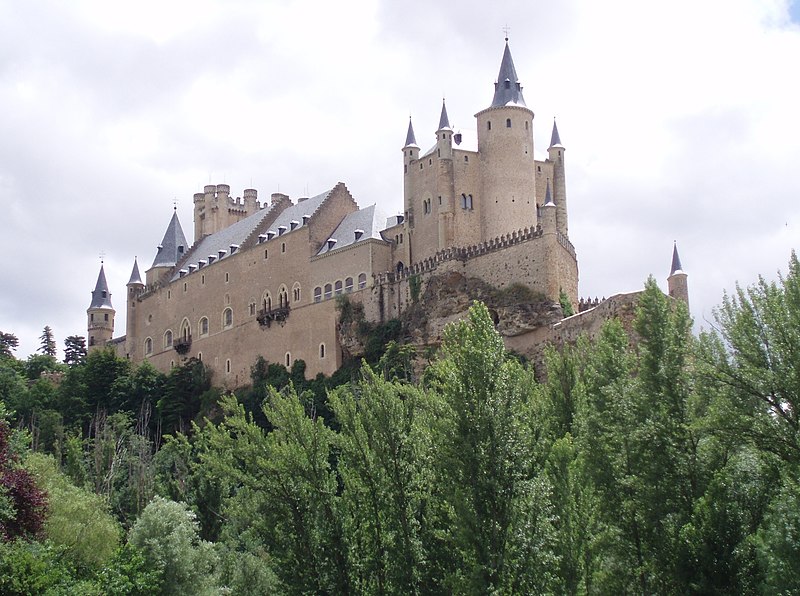The Alcázar of Segovia (literally, Segovia Castle) is a castle, located in the old city of Segovia, Spain. Rising out on a rocky crag above the confluence of two rivers near the Guadarrama mountains, it is one of the most distinctive castle-palaces in Spain by virtue of its shape â€" like the bow of a ship. The Alcázar was originally built as a fortress but has served as a royal palace, a state prison, a Royal Artillery College and a military academy since then. It is currently used as a museum and a military archives building.
History

The Alcázar of Segovia, like many fortifications in Spain, started off as an Arab fort, which itself was built on a Roman fort but little of that structure remains. The first reference to this particular Alcázar was in 1120, around 32 years after the city of Segovia returned to Christian hands (during the time when Alfonso VI of León and Castile reconquered lands to the south of the Duero river down to Toledo and beyond). However, archaeological evidence suggests that the site of this Alcázar was once used in Roman times as a fortification.
The shape and form of the Alcázar was not known until the reign of King Alfonso VIII (1155â€"1214), however early documentation mentioned a wooden stockade fence. It can be concluded that prior to Alfonso VIII's reign, it was no more than the wooden fort built over the old Roman foundations. Alfonso VIII and his wife, Eleanor of Plantagenet made this Alcázar their principal residence and much work was carried out to erect the beginnings of the stone fortification we see today.
The Alcázar, throughout the Middle Ages, remained one of the favorite residences of the monarchs of the Kingdom of Castile and a key fortress in the defence of the kingdom. It was during this period a majority of the current building was constructed and the palace was extended on a large scale by the monarchs of the Trastámara dynasty.
In 1258, parts of the Alcázar had to be rebuilt by King Alfonso X of Castile after a cave-in and soon after the Hall of Kings was built to house Parliament. However, the single largest contributor to the continuing construction of the Alcázar is King John II who built the "New Tower" (John II tower as it is known today).
In 1474, the Alcázar played a major role in the rise of Queen Isabella I of Castile. On 12 December news of the King Henry IV's death in Madrid reached Segovia and Isabella immediately took refuge within the walls of this Alcázar where she received the support of Andres Cabrera and Segovia's council. She was crowned the next day as Queen of Castile and León.
The next major renovation at the Alcázar was conducted by King Philip II after his marriage to Anna of Austria. He added the sharp slate spires to reflect the castles of central Europe. In 1587, architect Francisco de Morar completed the main garden and the School of Honor areas of the castle.
The royal court eventually moved to Madrid and the Alcázar then served as a state prison for almost two centuries before King Charles III founded the Royal Artillery School in 1762. It served this function for almost a hundred years until 6 March 1862 where a fire badly damaged the roofs of the treasury, keep, armory, sleeping quarters, and framework.
It was only in 1882 that the building was slowly restored to its original state. In 1896, King Alfonso XIII ordered the Alcázar to be handed over to the Ministry of War as a military college.
Interior

According to The Illustrated Magazine of Art (1853)
The original interior was badly damaged by fire in 1862, though it has since been partially restored. Today, the Alcázar remains one of the most popular historical sites in Spain and is one of the three major attractions in Segovia. Notable rooms are the Hall of Ajimeces which houses many works of art, the Hall of the Throne and the Hall of Kings with a frieze representing all of the Spanish Kings and Queens starting from Pelagius of Asturias down to Juana la Loca after moving to El Palacio Real in Madrid, Spain.
In popular culture

The castle was one of the inspirations for Walt Disney's Cinderella Castle.
References

Further reading

- Haliczer, Stephen (December 1976), "Political Opposition and Collective Violence in Segovia, 1475â€"1520", The Journal of Modern History 48 (4): 1â€"35, doi:10.1086/241530, JSTOR 1877303Â
External links

Media related to Alcázar of Segovia at Wikimedia Commons
- Castillos de España (Alcazar de Segovia)
- Alcázar de Segovia Information and Photos.
- Entry in Great Buildings website - Alcázar of Segovia.
- Alcázar of Segovia photos and history

